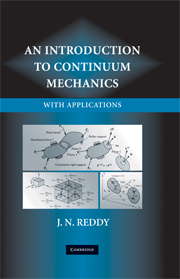Book contents
- Frontmatter
- Contents
- Preface
- 1 Introduction
- 2 Vectors and Tensors
- 3 Kinematics of Continua
- 4 Stress Measures
- 5 Conservation of Mass, Momenta, and Energy
- 6 Constitutive Equations
- 7 Linearized Elasticity Problems
- 8 Fluid Mechanics and Heat Transfer Problems
- 9 Linear Viscoelasticity
- References
- Answers to Selected Problems
- Index
4 - Stress Measures
- Frontmatter
- Contents
- Preface
- 1 Introduction
- 2 Vectors and Tensors
- 3 Kinematics of Continua
- 4 Stress Measures
- 5 Conservation of Mass, Momenta, and Energy
- 6 Constitutive Equations
- 7 Linearized Elasticity Problems
- 8 Fluid Mechanics and Heat Transfer Problems
- 9 Linear Viscoelasticity
- References
- Answers to Selected Problems
- Index
Summary
Most of the fundamental ideas of science are essentially simple, and may, as a rule, be expressed in a language comprehensible to everyone.
Albert EinsteinIntroduction
In the beginning of Chapter 3, we have briefly discussed the need to study deformation and stresses in material systems that we may design for engineering applications. All materials have certain threshold to withstand forces, beyond which they “fail” to perform their intended function. The force per unit area, called stress, is a measure of the capacity of the material to carry loads, and all designs are based on the criterion that the materials used have the capacity to carry the working loads of the system. Thus, it is necessary to determine the state of stress in a material.
In the present chapter, we study the concept of stress and its various measures. For instance, stress can be measured per unit deformed area or undeformed area. As we shall see shortly, stress at a point in a three-dimensional continuum can be measured in terms of nine quantities, three per plane, on three mutually perpendicular planes at the point. These nine quantities may be viewed as the components of a second-order tensor, called stress tensor. Coordinate transformations and principal values associated with the stress tensor and stress equilibrium equations will also be discussed.
Cauchy Stress Tensor and Cauchy's Formula
First we introduce the true stress, that is, stress in the deformed configuration κ that is measured per unit area of the deformed configuration κ.
- Type
- Chapter
- Information
- An Introduction to Continuum Mechanics , pp. 115 - 142Publisher: Cambridge University PressPrint publication year: 2007



